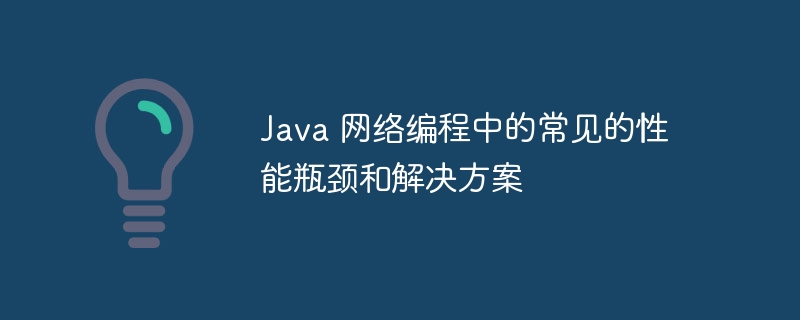Java 网络编程中的常见的性能瓶颈和解决方案
- WBOYWBOYWBOYWBOYWBOYWBOYWBOYWBOYWBOYWBOYWBOYWBOYWB原创
- 2024-05-09 14:30:02814浏览
Java 网络编程常见的性能瓶颈有:阻塞 I/O、高并发连接、慢速网络和代码效率不佳。解决方案包括:使用非阻塞 I/O、连接池、数据压缩和代码优化。例如,使用 NIO 非阻塞 I/O 优化服务器端网络性能,可以提高吞吐量和响应时间,因为它允许同时处理多个客户端连接。

Java 网络编程中常见的性能瓶颈和解决方案
在 Java 网络编程中,性能优化至关重要,因为它直接影响应用程序的响应速度和用户体验。以下是一些常见的性能瓶颈及其解决方法:
阻塞 I/O
瓶颈:阻塞 I/O 操作会在请求处理过程中阻塞线程,导致程序效率低下。
解决方案:使用非阻塞 I/O,例如 Java NIO 或异步 I/O,允许应用程序在等待 I/O 操作完成的同时继续处理其他任务。
高并发连接
瓶颈:大量并发连接会导致打开文件句柄过多,从而耗尽系统资源并导致程序崩溃。
解决方案:使用连接池来管理连接,并限制并发连接的数量。
慢速网络
瓶颈:网络延迟或带宽限制会导致应用程序响应缓慢,尤其是在处理大量数据时。
解决方案:使用数据压缩技术减小数据量,并使用高效的数据传输协议,例如 HTTP/2。
代码效率不佳
瓶颈:低效的代码实现会导致不必要的开销,影响性能。
解决方案:遵循最佳实践,例如避免不必要的对象创建、优化算法和正确使用缓存。
实战案例
以下是一个使用 NIO 非阻塞 I/O 优化服务器端网络性能的示例:
import java.io.IOException;
import java.net.InetSocketAddress;
import java.nio.ByteBuffer;
import java.nio.channels.SelectionKey;
import java.nio.channels.Selector;
import java.nio.channels.ServerSocketChannel;
import java.nio.channels.SocketChannel;
import java.util.Iterator;
public class NonBlockingEchoServer {
private static final int BUFFER_SIZE = 1024;
public static void main(String[] args) throws IOException {
ServerSocketChannel serverSocketChannel = ServerSocketChannel.open();
serverSocketChannel.bind(new InetSocketAddress(8080));
serverSocketChannel.configureBlocking(false); // 设置为非阻塞
Selector selector = Selector.open();
serverSocketChannel.register(selector, SelectionKey.OP_ACCEPT);
while (true) {
selector.select();
Iterator<SelectionKey> keys = selector.selectedKeys().iterator();
while (keys.hasNext()) {
SelectionKey key = keys.next();
keys.remove();
if (key.isAcceptable()) {
handleAccept(selector, serverSocketChannel);
} else if (key.isReadable()) {
handleRead(key);
} else if (key.isWritable()) {
handleWrite(key);
}
}
}
}
private static void handleAccept(Selector selector, ServerSocketChannel serverSocketChannel) throws IOException {
SocketChannel socketChannel = serverSocketChannel.accept();
socketChannel.configureBlocking(false);
socketChannel.register(selector, SelectionKey.OP_READ);
}
private static void handleRead(SelectionKey key) throws IOException {
SocketChannel socketChannel = (SocketChannel) key.channel();
ByteBuffer buffer = ByteBuffer.allocate(BUFFER_SIZE);
int readBytes = socketChannel.read(buffer);
if (readBytes > 0) {
buffer.flip();
// 处理收到的数据
}
}
private static void handleWrite(SelectionKey key) throws IOException {
SocketChannel socketChannel = (SocketChannel) key.channel();
// 处理准备发送的数据
int writeBytes = key.channel().write(ByteBuffer.wrap("响应数据".getBytes()));
}
}通过使用 NIO 和非阻塞 I/O,服务器可以同时处理多个客户端连接,提高吞吐量和响应时间。
以上是Java 网络编程中的常见的性能瓶颈和解决方案的详细内容。更多信息请关注PHP中文网其他相关文章!
声明:
本文内容由网友自发贡献,版权归原作者所有,本站不承担相应法律责任。如您发现有涉嫌抄袭侵权的内容,请联系admin@php.cn

